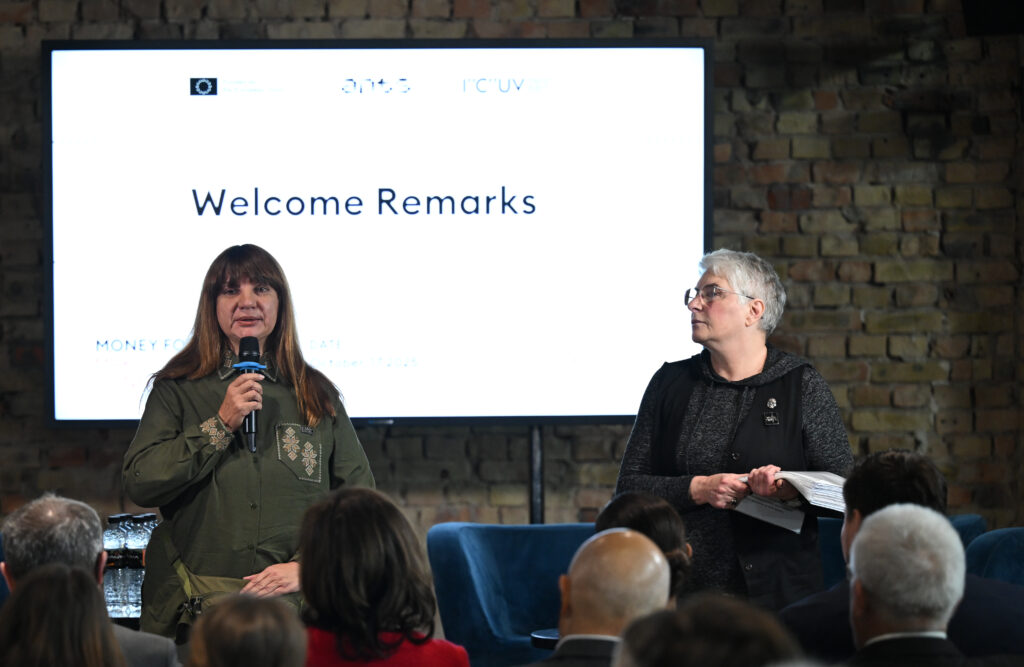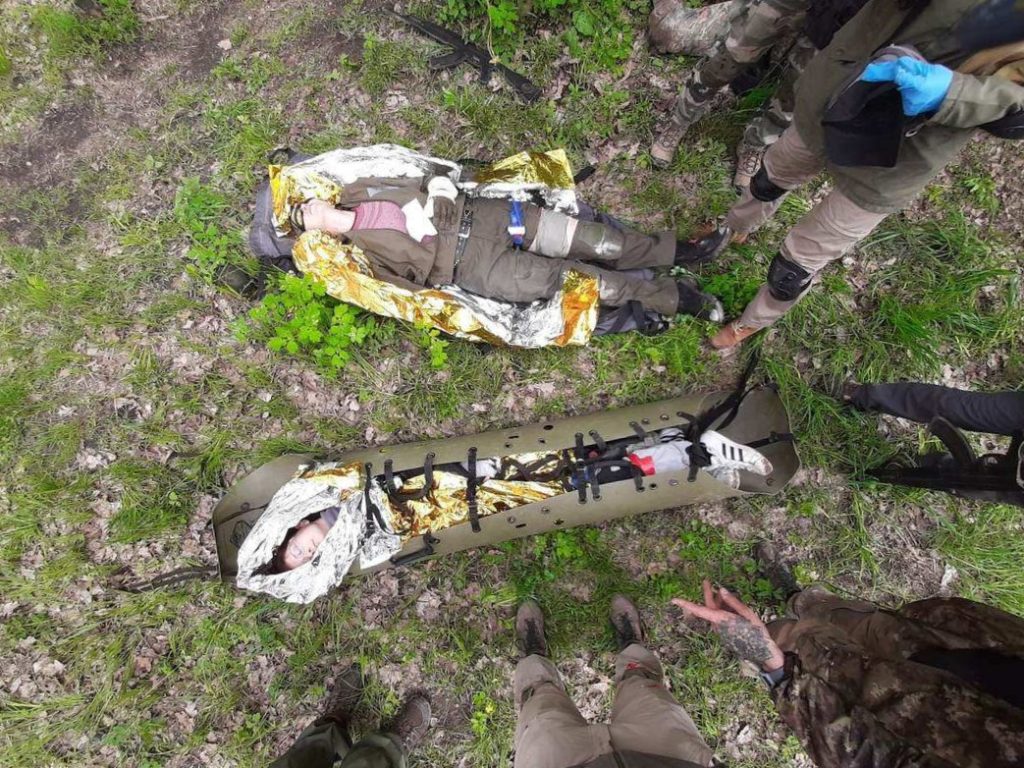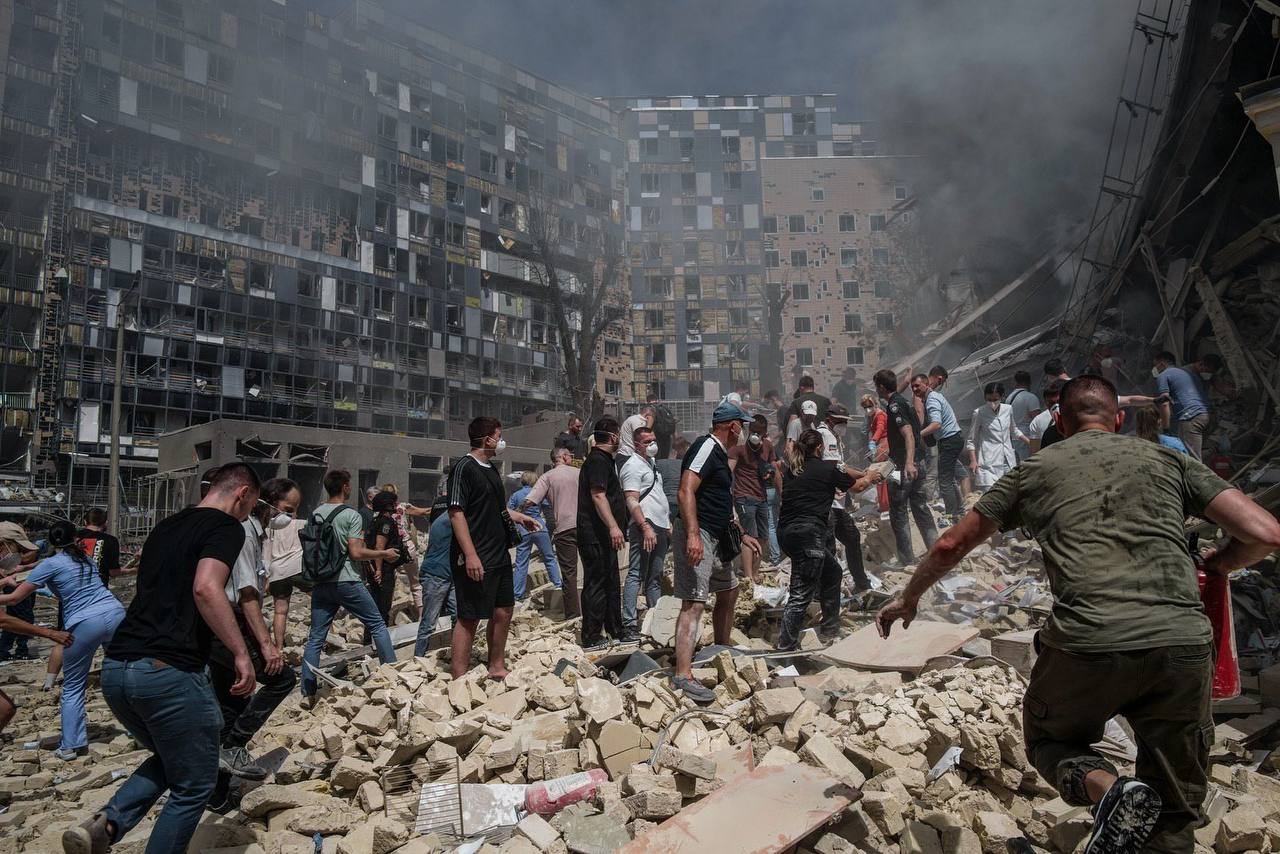“Who here has a first aid kit in their bag?” Diana Makarova asks. The venue is a basement nightclub in Kyiv called “Heaven”—one of many underground spaces where the city now holds its public events. Hotel cellars, parking garages, below-ground nightclubs—anywhere deep enough to be safe during air raids.
Diana’s question is answered with silence. There are roughly 50 people here—Ukrainian officials, European diplomats, aid workers, civil society leaders, journalists, students—who have gathered on 17 October to discuss confiscating frozen Russian assets and funding Ukraine’s defense. Not a single hand goes up.
“A tourniquet?”
One woman raises her hand. One person out of 50.
Still not prepared
Makarova, head of the charitable foundation F.O.N.D. and a battlefield volunteer since 2014, lets the silence settle. “You’re still not prepared,” she says. “Even now, after everything, you’re not prepared.”
At the “Money for Victory: Make Russia Pay” conference, organised by the International Centre for Ukrainian Victory (ICUV) and National Interests Advocacy Network (ANTS), Makarova and volunteer movement coordinator Oksana Korchynska warn the room—and the world beyond: The volunteer system, which has been taken for granted for far too long both by Ukraine’s Defense Forces and Ukrainian state and society, is collapsing. Kill zones are replacing contact lines on the front.
And the West is repeating Ukraine’s fatal mistakes from 2014.
The message from two gruff and battle-hardened women in their 50s, invited to give welcoming remarks at the conference, is far more serious than the organizers probably expected: The war you think will stay in Ukraine is already transforming in ways your institutions can’t imagine. Don’t wait 10 years like Ukraine did. And Ukrainians themselves, nearly four years into full-scale invasion, still haven’t grasped how unprepared they remain.

When doctors weren’t ready either
Korchynska knows this pattern well. She saw it firsthand at Okhmatdyt Children’s Hospital on 8 July 2024, 40 minutes after the Russian missile struck.
As a battlefield medic and founder of the Recovery Center for Wounded Soldiers who had treated countless wounded soldiers since 2014 and as a member of the hospital’s supervisory board, she knew every nook and cranny there.
What shocked her wasn’t the attack. It was the doctors.
“Two years into the full-scale invasion, they were stunned that a children’s hospital could be hit,” Korchynska says. “They were scattered, in shock, some ignoring their own wounds to save others. I had to order them: ‘Please, wounded staff go to triage, you need help too!’”
Even medical professionals believed the hospital was somehow exempt, despite news reports telling otherwise. If doctors in Kyiv weren’t prepared after two years of war, what hope does Europe have?
The decade nobody listened
Korchynska started receiving first wounded from Donbas on 29 June 2014. After Ukraine’s Revolution of Dignity ousted a pro-Russian president earlier that year, Russia annexed Crimea and backed separatists in eastern Ukraine—triggering what many Ukrainians initially dismissed as a distant regional conflict.
By late August, Korchynska lived through the Ilovaisk massacre—when Russian generals promised safe passage to encircled Ukrainian forces, then slaughtered them with tank fire.
“More than 600 people died. We could only identify 369 bodies because the rest were burned beyond recognition,” Korchynska says.
“That’s what Russian promises cost.”
Both her sons were wounded in combat. Her granddaughters—one survived shelling in Irpin, the other now studies in Kyiv, where lectures are held in bomb shelters.
For 10 years, Oksana Korchynska and others from the front tried to warn the rest of Ukraine that larger war was coming. “People looked at us strangely,” she says. Nobody believed. Ukrainians in Kyiv, Lviv, Poltava thought Donbas was far away. Many trusted Russian narratives suggesting the war was a local uprising.
Then 24 February 2022 arrived.
Europeans are making the same mistake
“I recently traveled to Europe—Poland, France, Italy,” Korchynska says. “Our European friends reminded me of Ukrainians who didn’t believe for 10 years that war would come to their cities.”
Kyiv residents thought Donbas was far away. Now Europeans think Ukraine is far away. Yet, as she explains, the perceived distance doesn’t matter. The war came anyway. It always does.
On 3 September 2024, Russian missiles struck a military institute in Poltava, killing 59 and injuring over 300. Among the wounded was a 30-year-old IT specialist at his office desk.
“He told me, ‘I still didn’t believe it would happen to me,’” Korchynska says. “He didn’t have a first aid kit.” She pauses, looking at the conference attendees, who shift uncomfortably.
“Even now, you don’t. You’re still not prepared. You still think this is far away.”

Feels like 2014 again
Trending Now
The unpreparedness Korchynska describes has concrete consequences.
In 2014, Ukrainian volunteers equipped nearly everything the Defense Forces needed. By 2022, the military was better supplied, though volunteers still filled critical gaps. Now, in 2025, frontline units again ask for basics neither the army nor volunteers can meet.
“The third phase of the war is beginning,”
Makarova says. “And it doesn’t smell like 2022. It smells like 2014.” The first phase lasted from 2014 to 2022, with limited conflict in Donbas, where volunteers equipped nearly everything.
The second began in February 2022—full-scale invasion with better military supplies and Western aid flowing.
Now comes the third: kill zone warfare, where drones control access to the front, and the volunteer system that sustained Ukraine for a decade is collapsing.
The kill zone economy
Ukraine’s Commander-in-Chief Oleksandr Syrskyi reported on 14 October that strike drones expanded the “kill zone” on the front line to 10 kilometers. Vehicles can’t reach soldiers in forward positions anymore. The entire supply model has collapsed. Everything must be light and small enough for land or air drone delivery. Everything becomes exponentially more expensive per unit delivered.
Western military aid packages assume logistics chains that don’t exist anymore. Nobody planned for this.
“Soldiers are stationed three to four months in positions vehicles can’t reach,” Makarova explains.
“Everything must be delivered by drones. Light food—freeze-dried meals. But Ukraine’s volunteer system is breaking under this new reality.”
A battalion commander recently told Makarova he needed monthly 10,000 construction staples—steel rods bent and sharpened on both ends to hold wooden beams used in frontline fortifications together. Each costs 16 hryvnias, about 38 US cents.
The math: 10,000 staples at 38 cents equals $3,800. Just for one battalion. Just for one month. Makarova could afford only 2,000, which she paid from her own pocket.
“I don’t have the money,” she says flatly.
Then there are tourniquets. Each soldier needs four. A set costs 1,500 hryvnias ($36). Soldiers buy their own. When they can’t, volunteers try to fill the gap—and increasingly can’t.
“Large volunteer organizations buy drones and vehicles in bulk,” Makarova says. “We mid-tier volunteers hold the ‘body of the front’—construction materials, generators, vehicle repairs, anti-drone nets. Staples. I sat down with volunteers and military personnel. We realized we can’t sustain this.”
The complexity extends beyond supplies to saving lives themselves.
“This is a special operation now,”
Korchynska adds. “British intelligence officers asked why I keep calling wounded evacuation a ‘special operation.’ We have to calculate how many drones control the sky, how we’ll extract soldiers. We can’t work with armored vehicles on the front line anymore—only ground evacuation drones.”
Even medical protocols from 2014 don’t work. “The ones I taught in Tactical Combat Casualty Care—battlefield medical protocols used by NATO forces—don’t work anymore,” she says. “Our wounded are delayed casualties. We can’t evacuate on time because of drones.”
The war transformed faster than any institution could keep up—military, government, volunteers, all of them.
The warning
“This isn’t the war Europe imagines,” Oksana Korchynska concludes. “Europe still imagines World War II. That war won’t come back. Don’t learn these lessons the hard way. We have the experience. Help us to save Ukraine, Europe, and the world.”
The conference ends. Attendees climb the stairs from “Heaven” nightclub back to street level, emerging into a golden October afternoon—sun, wind, yellow leaves skittering across the pavement. Up here, in the light and ordinary weather, the warnings from the basement feel abstract. Distant.
That’s always how it feels. Until it doesn’t.

